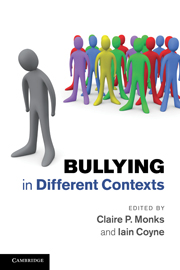Book contents
- Frontmatter
- Contents
- List of figures
- List of tables
- Notes on contributors
- 1 A history of research into bullying
- 2 Peer-victimisation in preschool
- 3 Bullying in schools: thirty years of research
- 4 Peer violence in residential children's homes: a unique experience
- 5 Domestic violence: bullying in the home
- 6 Juvenile dating and violence
- 7 Bullying in prisons: bringing research up to date
- 8 Bullying in the workplace
- 9 Elder abuse and bullying: exploring theoretical and empirical connections
- 10 Cyberbullying
- 11 An overview of bullying and abuse across settings
- Index
- References
1 - A history of research into bullying
Published online by Cambridge University Press: 05 June 2012
- Frontmatter
- Contents
- List of figures
- List of tables
- Notes on contributors
- 1 A history of research into bullying
- 2 Peer-victimisation in preschool
- 3 Bullying in schools: thirty years of research
- 4 Peer violence in residential children's homes: a unique experience
- 5 Domestic violence: bullying in the home
- 6 Juvenile dating and violence
- 7 Bullying in prisons: bringing research up to date
- 8 Bullying in the workplace
- 9 Elder abuse and bullying: exploring theoretical and empirical connections
- 10 Cyberbullying
- 11 An overview of bullying and abuse across settings
- Index
- References
Summary
General overview of and rationale for the book
Bullying is widely recognised as being a problem, not only for those individuals involved, but also for the organisation within which it occurs and the wider community. Few people can be unaware of bullying, either having been involved in it (as a perpetrator or target), having witnessed it occurring or seen it reported within the local or national media. Although bullying has long been recognised as an issue that warrants concern and action, empirical research on the topic only really began in the late 1970s. Since this time, there have been many books and journal articles published on this important topic. Work on dealing with and preventing bullying has come from many different quarters, from governments creating laws for dealing with and punishing bullying, and drawing up legal guidelines for institutions to follow with the aim of preventing bullying, to practitioners developing models of intervention and prevention work with those suffering or at risk of being involved in bullying.
We currently have an established body of research focusing on the nature and extent of bullying, as well as highlighting some of the risk factors for involvement in bullying (both individual and situational) across a number of different contexts. Much of this research could be criticised as being somewhat atheoretical and descriptive. However, the authors within this volume have drawn on theory in an attempt to develop models to further our understanding of the phenomenon.
- Type
- Chapter
- Information
- Bullying in Different Contexts , pp. 1 - 11Publisher: Cambridge University PressPrint publication year: 2011
References
- 4
- Cited by



